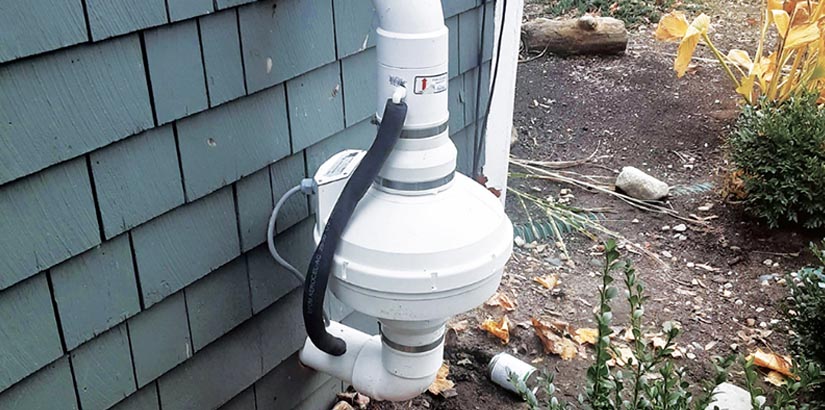Radon is a silent intruder. You can’t see it, you can’t smell it, and you certainly can’t taste it, but it’s there, lurking beneath your home, waiting to make its move. Radon gas is a naturally occurring radioactive gas that can pose serious health risks if it accumulates in your home. For homeowners with slab-on-grade houses, understanding and implementing effective radon mitigation strategies is crucial to ensuring a safe living environment.
Table of Contents
What Are Slab-on-Grade Houses?
Slab-on-grade houses are a common type of construction found primarily in warm climates. Unlike homes with basements or crawl spaces, slab-on-grade houses are built directly on top of a concrete slab. This construction technique is particularly useful in areas with high water tables or bedrock close to the surface. The slab provides a solid foundation that can support the weight of the house, often reinforced with post-tension cables or steel rods (rebar) to prevent cracking and increase stability.
However, this construction style presents unique challenges when it comes to radon mitigation. Because there’s no basement or crawl space, traditional mitigation techniques must be adapted to ensure effectiveness. Let’s delve into the various methods available for radon mitigation in slab-on-grade houses, each designed to reduce radon levels and protect your home and health.
Sub-Slab Depressurization
What Is Sub-Slab Depressurization?
Sub-slab depressurization is the most common and effective method for mitigating radon in slab-on-grade houses. This technique involves creating a pressure differential that prevents radon gas from entering the home by drawing air from beneath the slab and venting it safely outside.
How It Works
The process begins by drilling a hole through the concrete slab, typically in a central location within the home. A suction pipe is then inserted through this hole and extended into the crushed rock or soil underneath. This pipe is connected to a vent fan, which continuously pulls air from beneath the slab. The suction created by the fan lowers the pressure beneath the slab, preventing radon gas from seeping into the house and directing it safely outside.
Installation and Effectiveness
Installing a sub-slab depressurization system can be complex and usually requires professional expertise. The placement of the suction pipe, the power of the vent fan, and the type of soil or rock beneath the slab all influence the system’s effectiveness. When properly installed, sub-slab depressurization can significantly reduce radon levels, often by 90% or more.
Advantages and Disadvantages
Advantages:
- Highly effective at reducing radon levels
- Continuous operation provides constant protection
- Can be adapted to various slab-on-grade house designs
Disadvantages:
- Requires professional installation and maintenance
- Can be costly upfront
- Requires electricity to operate the vent fan
Drain Tiles or Perforated Pipe
Using Existing Drainage Systems
Many slab-on-grade houses are equipped with drain tiles or perforated pipes designed to direct water away from the foundation. These systems can be adapted for radon mitigation by adding suction to draw out radon gas along with water.
How It Works
In this method, a suction fan is connected to the existing drain tiles or perforated pipes. The fan creates a vacuum that pulls radon gas from beneath the slab and directs it outside. This technique leverages the existing drainage infrastructure, making it a cost-effective option for many homeowners.
Installation and Effectiveness
This method is generally easier and less invasive than sub-slab depressurization, as it utilizes existing systems. However, its effectiveness can vary based on the condition and design of the drainage system. Proper sealing of the system and careful placement of the suction fan are crucial for optimal performance.
Advantages and Disadvantages
Advantages:
- Utilizes existing infrastructure, reducing installation costs
- Less invasive than other methods
- Can effectively reduce radon levels when properly installed
Disadvantages:
- Effectiveness depends on the condition and design of the drainage system
- May require additional sealing and maintenance
- Less effective in homes without existing drain tiles or perforated pipes
Sump Hole Suction
What Is Sump Hole Suction?
Sump hole suction is a variation of the sub-slab depressurization method, specifically designed for homes with sump pumps. This technique involves using the sump pump system to create suction and remove radon gas.
How It Works
In homes with a sump pump, the sump pit can be sealed with a special cover that includes a suction pipe. The suction pipe is connected to a vent fan, which pulls radon gas from beneath the slab and directs it outside. The sump pump continues to function normally, removing unwanted water while the sealed sump pit prevents radon from escaping into the home.
Installation and Effectiveness
Sump hole suction is relatively easy to install and can be a cost-effective solution for homes with existing sump pumps. Proper sealing of the sump pit and the correct placement of the suction pipe and fan are essential for maximum effectiveness. This method can significantly reduce radon levels, though its effectiveness may vary based on the design of the sump pump system.
Advantages and Disadvantages
Advantages:
- Utilizes existing sump pump system, reducing installation costs
- Less invasive than other methods
- Can effectively reduce radon levels when properly installed
Disadvantages:
- Requires proper sealing of the sump pit
- Effectiveness depends on the design of the sump pump system
- Less effective in homes without sump pumps
Block Wall Suction
What Is Block Wall Suction?
Block wall suction is a radon mitigation technique recommended for homes with hollow block foundation walls. This method involves creating suction within the hollow walls to draw radon gas from the ground and prevent it from entering the home.
How It Works
In this method, a series of holes are drilled into the hollow block walls, and suction pipes are inserted. These pipes are connected to a vent fan, which creates a vacuum that pulls radon gas from the ground and directs it outside. The increased pressure within the walls and ground traps the radon gas, preventing it from entering the living space.
Installation and Effectiveness
Block wall suction requires professional installation due to the complexity of drilling into the walls and correctly placing the suction pipes. When properly installed, this method can be highly effective in reducing radon levels, especially in homes with significant radon infiltration through foundation walls.
Advantages and Disadvantages
Advantages:
- Highly effective for homes with hollow block walls
- Provides continuous protection against radon infiltration
- Can significantly reduce radon levels when properly installed
Disadvantages:
- Requires professional installation and maintenance
- Can be invasive and costly
- Less effective in homes without hollow block walls
Conclusion
Radon mitigation is a critical aspect of maintaining a safe and healthy home, especially for slab-on-grade houses. By understanding the various mitigation methods available, homeowners can choose the most effective solution for their specific needs. Whether it’s sub-slab depressurization, drain tiles, sump hole suction, or block wall suction, each method offers unique advantages and challenges. Professional installation and regular maintenance are key to ensuring the effectiveness of any radon mitigation system.
FAQs
Q1: What is the best method for radon mitigation in slab-on-grade houses?
A1: The best method depends on your home’s specific conditions. Sub-slab depressurization is the most common and effective, but other methods like drain tiles, sump hole suction, and block wall suction can also be effective depending on the home’s design and existing infrastructure.
Q2: How can I test for radon in my slab-on-grade house?
A2: You can use a radon test kit available at most hardware stores or hire a professional to conduct a radon test. It’s recommended to test your home every two years or after any major renovations.
Q3: Is radon mitigation expensive?
A3: The cost of radon mitigation can vary based on the method used and the specific requirements of your home. Professional installation can range from a few hundred to several thousand dollars, but the investment is worth the peace of mind and health benefits.




